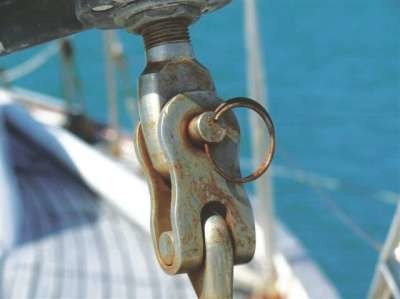Types Of Stainless Steel A2 vs A4 or 304 vs 316
At Boat Fittings the vast majority of our stainless steel fasteners (nuts, bolts and washers) as well as our shackles, cleats hinges and deck fittings are 316 (sometimes called A4) and more generally known as Marine Grade Stainless Steel. In our experience no commonly used stainless steel is absolutely 100% guaranteed not to suffer from any staining (ie light surface rust) when subjected to marine (ie salt water) conditions for an extended period of time.
That said, there are two main classifications of stainless steel commonly available and in use. These are called A2 and A4. A2 is also known as 304, whereas A4 is also known as 316. When buying stainless steel for external marine use (on the outside of our boat) we should choose A4 (316) if we want it to keep it’s shiny stain-free appearance over the seasons. If we use A2 stainless parts on the outside of our boat it will only be a matter of time before some degree of surface rust (staining) becomes visible like in the photograph below.
For internal fittings and fixtures (ie on the inside of the boat) as long as they are not likely to be submerged in areas of the bilges, A2 fixings and fittings are less likely to be an issue. This is the reason that a few of the hinges that we sell at boatfittings.co.uk are A2 grade and these would be generally fine for inside lockers, chart table lids etc. We would not recommend them for external marine use unless a degree of staining is acceptable. This is more often a cosmetic issue rather than a structural or functional problem.
For some reasons in the manufacturing supply chain it is more common for cast components (eg cleats, fairleads and the thicker types of hinges) to be made from 316 stainless, where as parts made from thinner-wall stainless steel which are bent or pressed into their final shape are more commonly available in 304 (ie not marine-grade).
Vehicle Applications
Many hobbyists buy stainless nuts, bolts and washers to replace rusty fixings on their classic cars or motorbikes. We do not advise using stainless steel fixings on structurally important areas such as suspension systems or engines unless you are sure that the replacement fixing is at least the same strength grade as the original. Many bolts in vehicles are high strength steel and might have yield strengths in excess of 1000 MPa. Our stainless steel nuts and bolts (set screws) are considerably less strong than most high-strength bolts.
Technical Information On Stainless Steel Grades
For a brief technical explanation of stainless steel and its chemical composition and grades please read on …….
Stainless steel differs from carbon steel by the amount of chromium present. Unprotected carbon steel rusts readily when exposed to air and moisture. This iron oxide film (the rust) accelerates corrosion by forming more iron oxide. Stainless steels contain sufficient chromium to form a passive film of chromium oxide, which prevents further surface corrosion and blocks corrosion from spreading into the metal’s internal structure. Passivation only occurs if the mixture of chromium is high enough.
Other alloying elements are added to enhance the structure and properties such as formability, strength and cryogenic toughness. These include metals such as:
Nickel, Molybdenum, Titanium, Copper
Non-metal additions are also made, the main ones being:
Carbon, Nitrogen
Grades of stainless steel A2, A4 in relation to fasteners. To all intents and purposes, when we see type A2 stainless steel, we can also call it Type 304. Likewise A4 grade can be called type 316.
Stainless steel, when used for fasteners (nuts, bolts, screws etc) have British standards. BSENISO 3506 replaces BS6105. Part 1 covers bolts, screw and studs, part 2 nuts and part 4 tapping screws.
A2 > Type 304 can also be called 18/8 because it ‘approximately’ contains 18% Chromium and 8 % nickel
However, for marine conditions you need more resistance to corrosion. Adding molybdenum (2-3%) to the mix provides this extra cover – and gives us the A4 grade
A4 grade then is also austenitic, (nearly*) non magnetic and suitable for all the situations as A2 but has the added advantage of being suitable for marine solutions. Often called Marine Grade stainless steel. The molybdenum increases the corrosion resistance to withstand attack from many industrial chemicals and solvents and chlorides. Used in the production of inks, photographic chemicals, surgical implants, and the marine environment
Both A2 and A4 grades come in three property classes: 50 (soft) , 70 (cold-worked) & 80 (high-strength) – the most common of which is the 70 class which is cold drawn and is the material used for our fasteners.
The A4-70 class has a typical tensile strength of 700 Nmm-2 and 450 Nmm-2 proof stress.
* See our article on stainless steel and magnetism
If you found this guide useful or interesting you might like to sign up to our newsletter, so that we can let you know when our next guide has been published.


